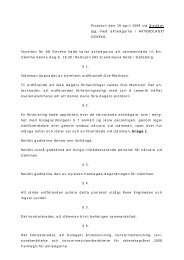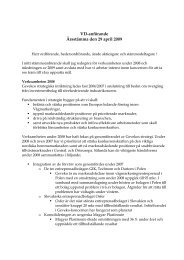PDF Document 2.46 MB - Geveko
PDF Document 2.46 MB - Geveko
PDF Document 2.46 MB - Geveko
You also want an ePaper? Increase the reach of your titles
YUMPU automatically turns print PDFs into web optimized ePapers that Google loves.
Financial Reports / Accounting and valuation principlesAccounting and valuation principles(Amounts in thousand Swedish kronor, except where otherwise stated)AB <strong>Geveko</strong>’s consolidated financial statementsare made up in accordance with theAnnual Accounts Act, RR30 SupplementaryAccounting Regulations for Groups andInternational Financial Reporting Standards(IFRS) as adopted by the EU. The consolidatedfinancial statements are made up in accordancewith the acquisition value method,except as regards financial assets and liabilities(including derivative instruments) valued atfair value via the profit and loss account.Making up the report in accordancewith IFRS requires the use of some keyestimates for accounting purposes. It alsorequires management to make certainassessments when applying the Group’saccounting principles. The areas that requirea high level of assessment due to their complexity,or such areas where the assumptionsand estimates are of great significance forthe consolidated financial statements, arelisted in note 36.Standards, amendments and interpretationsthat came into effect in 2007IFRS 7, Financial instruments, disclosures,and the complementary amendment to IAS 1Presentation of Financial Statements, Dis -closure of Capital, introduce new disclosurerules for financial instruments. IFRS 7 has noeffect on the classification and valuation ofthe Group’s financial instruments.IFRIC 8, Scope of IFRS 2 requires thattransactions that affect the issue of equityinstruments – where the proceeds receivedfall short of the fair value of the issued equityinstrument – be reviewed to determine ifthey fall within the scope of IFRS 2. Thisinterpretation has no effect on the consolidatedfinancial statements.IFRIC 10, Interim Financial Reportingand Impairment does not permit the impairmentof goodwill, placements in equityinstruments and placements in financialassets that are stated at historic cost in oneperiod to be accounted for as of a closingdate in a later period. This interpretation hasno effect on the consolidated financial reports.Standards, amendments and inter -pretations that came into effect in 2007but that are not relevant to the GroupThe following standards, amendments andinterpretations of published standards aremandatory for financial years beginning after1 January 2007 or later, but are not relevantto the Group:IFRS 4, Insurance contracts, IFRIC 7,Application of inflation-adjustments methodsin accordance with IAS 29, Financial reportingin Hyperinflationary Economies, and IFRIC 9Reassessment of Embedded Derivatives.New IFRS standards and IFRIC interpretationsthat have not yet come into effect orbeen applied by <strong>Geveko</strong> but that are consideredlikely to have an effect on the Group.IFRS 8, Reporting by Segment (applicable from1 January 2009). IFRS 8 replaces IAS 14 andadapts reporting by segment to the criteria inUS standard SFAS 131 Disclosures aboutsegments of an enterprise and related information.The new standard requires the informationby segment to be presented from theperspective of the company’s management,which means that it is presented in the sameway as in the internal reporting. The company’smanagement is currently examining whateffect the standard will have on the company’sorganisation of its activities. The Group willapply IFRS 8 with effect from 1 January 2009.Parent company accounting principlesThe parent company has made up thisannual report in accordance with the AnnualAccounts Act (1995:1554) and the SwedishFinancial Accounting Standards Council’srecommendation RR 32 Financial ReportingJuridical Persons. RR 32 means that theparent company, in the annual report for thejuridical person shall apply all IFRS andrecommendations approved by the EU insofaras this is possible within the framework ofthe Annual Accounts Act and taking intoconsideration the connection between theaccounts and taxation. The recommendationstates which exceptions from and additionsto IFRS are to be made. The parent company’saccounting principles are unchanged fromthe previous year. In the event of any discrepanciesbetween the Group’s accountingprinciples and those of the parent company,attention will be drawn to them in therespective section below.Basic definitionsAn asset is a resource that is controlled bythe Group as a consequence of past eventsand that is expected to generate financialbenefits for the Group in the future.A liability is an existing commitmentthat is a consequence of past events and thatis expected to lead to an outflow of resourcesfrom the Group that will involve financialcosts in the future.Equity consists of the Group’s netassets, i.e. it is the difference between itsassets and liabilities.Income is an increase in financial valueduring an accounting period as a consequenceof payments received, an increase inthe value of assets, or a decrease in the valueof liabilities, the consequence of which thereis an increase in the equity, except for suchin creases in equity as are the result of injectionsof capital by the shareholders.A cost is a decrease in the financialvalue of the Group during an accountingperiod as a consequence of payments made,a decrease in the value of assets, or anincrease in liabilities, the consequence ofwhich there is a decrease in equity, exceptfor such reductions in equity as are the resultof payments to shareholders.An item is included in the accounts ifit is covered by the definitions of asset, lia -bility, equity, income or cost, when:a) the financial benefits associated with theitem will probably be received by or withdrawnfrom the Group in the future, andb) the item’s cost or value can be measuredin a reliable way.Consolidated financial statements andcompany acquisitions IAS 27, IFRS 3The consolidated financial statements in -clude subsidiary companies over which theparent company exercises control, direct orindirect, which normally means control overmore than 50 per cent of the votes.Companies acquired during the yearare included in the consolidated financialstatements at an amount that relates to thepost-acquisition period. The results of companiesdivested during the year are includedin the consolidated profit and loss accountfor the period up until the divestment date.The purchase method is used foraccounting for the Group’s acquisitions ofsubsidiaries. The purchase cost of an acquisitionconsists of the fair value of assetsacquired and accrued or taken over liabilitiesas of the transfer date, plus costs directlyattributable to the acquisition.Identifiable acquired assets andassumed liabilities and any commitmentsassociated with an acquisition are initiallyvalued at their fair value on the acquisitiondate, regardless of the extent of any minorityinterests. The surplus, which consists of thedifference between the historic cost and thefair value of the Group’s share of the identifiableacquired net assets, is stated as goodwill.If the historic cost falls short of the fairvalue of the acquired subsidiary company’snet assets, the difference is taken direct intothe profit and loss account.In the case of successive acquisitions,when control is attained and the net assetsof the acquired business are consolidated attheir fair value, an adjustment, if any, to thefair value of those assets that had alreadybeen consolidated is made in the form of arevaluation, and the amount of the increaseis stated among Reserves within Equity.Internal profits within the Group areeliminated in their entirety. Intra-Grouptransactions and balance sheet items, andunrealised profits on transactions betweenGroup companies are eliminated.Unrealised losses are also eliminatedexcept when the transaction serves as evidenceof the need for impairment of thetransferred asset. The accounting principlesfor subsidiary companies have, in applicablecases, been altered to guarantee consistentapplication of the Group’s principles.59
















